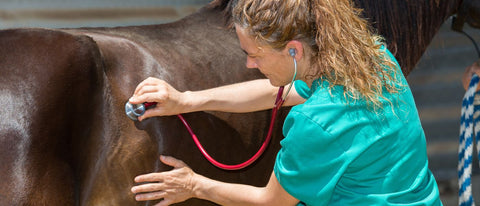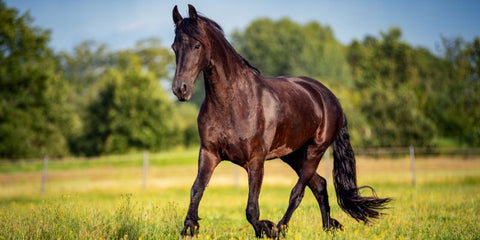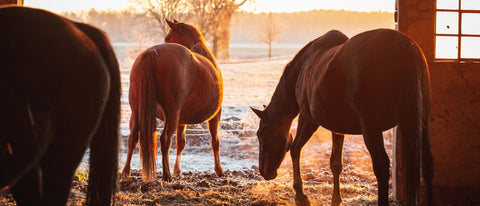
Florian ist aufgewachsen auf einem Bauernhof. Umgeben von Pferden, entdeckte er früh seine Faszination für diese majestätischen Tiere. Inspiriert von seiner reitbegeisterten Mutter, entwickelte er das Nahrungsergänzungmittel - Pferdegold. Seine tiefe Verbundenheit zur Natur und die leidenschaftliche Hingabe zu Pferden trieben ihn an, sein Unternehmen zu gründen.
If your horse has a fever, its body temperature will be elevated. Fever in horses is a defensive reaction of the body and manifests itself with various symptoms.
Fever is usually a sign of an infection. This article explains the causes and symptoms of fever and shows you how to help your horse.

What does fever mean for horses?
If your horse has a fever, its body temperature is elevated. The normal temperature for a horse is between 37 and 38.2 degrees Celsius . A fever up to 38.5 degrees Celsius is considered elevated.
Anything above 38.5 degrees Celsius is considered fever in horses.
The fever becomes dangerous when the body temperature exceeds 41 degrees Celsius .
Younger horses have a higher body temperature than older animals. It can even reach 39 degrees Celsius in very young foals.
For a young horse up to two years old, a body temperature of up to 38.5 degrees Celsius is still normal.
Fever is a defensive reaction of the body and an indication of an infection or horse disease.
The hypothalamus, located in the brain, instructs the body to raise its temperature. Pyrogens are fever-inducing substances that act on the body and raise its temperature.

Perfect for your horse: Pferdegold® supplementary feed!
These specially developed supplements support your horse's diet and provide it with natural nutrients. Made in Germany, grain-free and drug-free, they come with a 30-day money-back guarantee.
Try it now!Possible causes at a glance
Fever in horses can have various causes. It's often difficult for owners to determine the exact cause .
Therefore, if you notice fever in your horse, you should consult your veterinarian.
These are the most common causes :
- Infections caused by bacteria, viruses, fungi or parasites , for example strangles or herpes virus
- Allergies
- Poisoning by poisonous plants
- Heat stroke or overexertion
- Reaction to vaccinations
Heatstroke or overexertion is not strictly speaking a fever, but rather a form of hyperthermia. The horse reacts to heat or physical exertion by overheating.
Symptoms: What are typical accompanying symptoms of fever in horses?
The most important symptom of fever in horses is an elevated body temperature above 38.5 degrees Celsius. Other symptoms of fever in horses include:
-
Loss of appetite: A common symptom of fever is loss of appetite. Your horse will eat little or nothing and usually drink less than usual.
-
Lethargy: Your horse is weak, listless, and listless. It is inactive, shows a reluctance to move, and is unusually quiet and apathetic.
-
Altered breathing patterns: The horse's breathing is heavy and labored. Occasionally, it coughs or has nasal discharge.
-
Heavy sweating: Your horse is sweating more than usual, but you should be careful not to cause hyperthermia as a reaction to heat or physical exertion.
-
Swollen legs: When the horse has a fever, it may show edema in its legs.
-
Colic symptoms: A horse with a fever may exhibit colic symptoms, such as restlessness, rolling, and sweating. It may also be caused by a change in weather .
If you notice one or more of these symptoms along with fever, urgent action is required. It's time to consult your veterinarian.
How is fever diagnosed in horses?
You can diagnose fever in your horse by measuring its body temperature. Your veterinarian will conduct further tests to determine the cause and determine appropriate treatment.
To make a diagnosis, the veterinarian can take a blood sample and have it tested in the lab. An antibody test can detect specific pathogens in the blood.
The veterinarian may also take a nasal swab or nasal wash sample to detect certain pathogens.
Sometimes an ultrasound examination of the chest and abdomen is necessary, and sometimes an abdominal aspiration may also be necessary. For the upper respiratory tract, the veterinarian may perform an endoscopy.

Measuring a horse's fever - the best tips
Use a thermometer to measure the horse's body temperature in the anus . There are special thermometers for large animals, but you can also use a human thermometer. Since body temperature can be elevated due to exertion and can distort the reading, you should let your animal rest for at least 60 minutes before taking your temperature.
Create a relaxed situation and make sure your pet is not disturbed or distracted.
The following tips will help you measure your horse’s fever:
- Stand to the side of your horse's hind legs to avoid injuries from kicking .
- You can avoid attempts to escape by having a second person help you hold the horse and calm it down.
- Using cream, oil or water makes it easier to insert the thermometer and avoids injuries.
- During the entire measuring process , hold the thermometer firmly to avoid it getting into the intestine.
- Take another measurement a few minutes later to rule out possible measurement errors.
-
Always measure at the same time in the morning and evening over several days and compare the results.
Body temperature is always higher in the evening than in the morning. For reliable results , you should always measure your temperature in the morning and evening.
If the veterinarian has performed a rectal examination, the temperature in the anus will be lower. Therefore, wait a while before taking your horse's temperature to obtain a reliable result.
Treatment & Therapy: What can you do?
If your horse has a fever, it needs rest so its body can focus on healing the underlying condition . Whether veterinary consultation is necessary must always be determined on an individual basis.
If the fever does not last longer than two days and the body temperature is not 39 degrees Celsius or higher, you should monitor it.
If you have several horses, it's a good idea to isolate the sick horse from the other animals. Calling your veterinarian will be on the safe side. In any case, the veterinarian can determine the cause and treat your horse appropriately.
First aid for fever in horses
Give your horse plenty of water and encourage it to drink . If it refuses, you can add a little apple juice to the water for a better taste.
You can add one liter of apple juice to nine liters of water. Take your horse to a quiet, shady spot.
Don't cover the horse's back with a blanket, as this could cause its body temperature to rise even further. Only if it's sweating heavily can you use a sweat rug.
Our tip:
If the horse is sweating heavily, you can also apply leg wraps with cold water or gently spray the horse starting from the hind hooves and working upwards with lukewarm water.The optimal food: What should you pay attention to?
If your horse has a fever, you should give it easily digestible food, such as beet pulp or hay cubes . Vegetable oil can provide the horse with energy.
Don't give your horse more food than usual. If your horse is hungry, you can also feed him hay and mash.
Heavy sweating: Provide your horse with sufficient electrolytes!
Your horse loses a lot of fluid and electrolytes when it sweats heavily. It's therefore important that you provide it with electrolytes. You can simply add them to your horse's feed.
It is important to first feed electrolytes and then encourage your horse to drink.
Conclusion
A horse has a fever when its body temperature is higher than 38.5 degrees Celsius. It is a defensive reaction of the body that can have various causes.
An infection is often present. Depending on the cause, fever is accompanied by various symptoms such as lethargy, altered breathing patterns, and loss of appetite.
You should consult your veterinarian at the latest if the body temperature is above 39 degrees Celsius or if the fever lasts for more than two days. Take your horse's body temperature in the morning and evening. If your horse has a fever, it needs rest and cooling.
FAQ
When does a horse have a fever?
A horse has a fever when its body temperature is above 38.5 degrees Celsius.
Can you feel fever in a horse?
You can't always tell if your horse has a fever by touch. Often, you can tell if it's feverish because your horse is sweating heavily. To be sure, you should measure its body temperature.
When can you ride a horse again after a fever?
The rule of thumb for fever is that the horse needs a week of box rest for every day of fever. So, you should wait at least two to three weeks before riding it again and start riding slowly.
Important:
Pferdegold is not a substitute for veterinary diagnosis or treatment. The information contained in this article is for general informational purposes only and is intended to help improve your horse's well-being.
Pferdegold products do not treat or cure diseases , but rather support your horse in compensating for nutritional deficiencies through targeted nutrient intake .
However, they are not a substitute for professional advice from a veterinarian or specialist. If your horse has any health problems, we strongly recommend consulting a veterinarian. Pferdegold assumes no liability for decisions made based on the information provided here.
🐎 Want to learn more about the world of horses? Then read on:

















